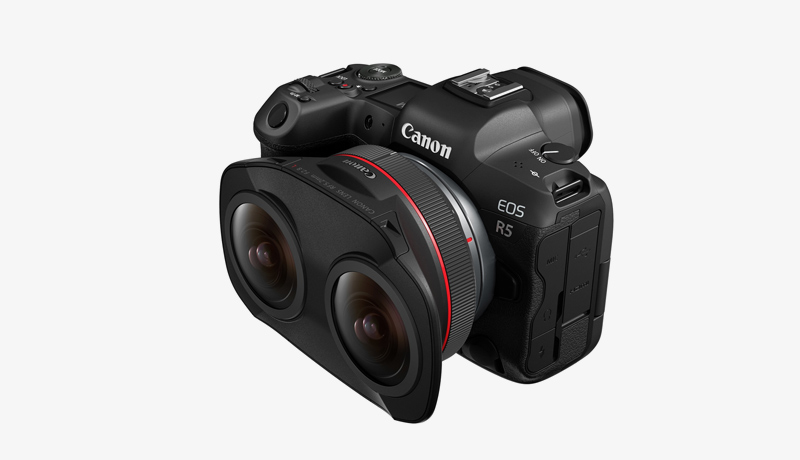
Canon reformed EOS VR System with Canon RF 5.2mm F.8L DUAL FISHEYE lens enables high quality 180° VR shooting. This ground-breaking new virtual reality capture solution takes advantage of the RF mount’s improved capabilities. The Canon EOS VR SYSTEM, which incorporates the Canon RF 5.2mm F2.8L DUAL FISHEYE lens, was created to the growing need for high-quality 3D 180° VR footage. With VR technology being more widely used in training, travel, sports, live events, and documentaries, Canon’s new solution streamlines the stereoscopic 180° VR capture and post-production process. The capacity of the EOS VR SYSTEM to provide an immersive experience immerses viewers in action by presenting professional images.
The Canon RF 5.2mm F2.8L DUAL FISHEYE lens is Canon’s first-ever interchangeable VR lens, designed to set up and capture 180° VR video and stills with the EOS R5 as simple as possible while maintaining the EOS R System‘s superior optical performance. For established VR content creators, professional production companies, and experts wishing to break into the VR market with a more efficient approach, this makes 3D content development more viable. Canon’sEOS VR SYSTEM also contains a newly built Canon VR software program (EOS VR Utility) and plug-in (EOS VR Plug-in for Adobe Premiere Pro) to speed the 180° VR post-production.
The Canon RF 5.2mm F2.8L DUAL FISHEYE dual forward-facing fisheye lenses have an ultra-wide 190-degree field of view, which enables stereoscopic VR capture. Therefore, Canon’s sophisticated lens design allows for the direct projection of two images onto the camera’s single sensor, resulting in flawless alignment and synchronization right out of the box. VR setup is easier than with a two-camera system because the lens is used in this fashion.
By capturing two images on a single sensor, both images have the same performance characteristics, avoiding small differences in image quality and exposure that can occur with other two-sensor systems. Furthermore, the two EMD (aperture) units, one for each lens, are accurately controlled to maintain a consistent exposure onto the sensor, reducing the need for post-production grading and expertise to match the left and right image output.
The tiny lens has a 60mm baseline distance and a sophisticated folding optical design for a natural-looking perspective. Engineered to work with compatible VR cameras like the Canon EOS R5, the system provides the portability and familiarity of the EOS System.
The stereoscopicCanon RF 5.2mm F2.8L DUAL FISHEYE lens has the distinctive red ring, indicating that it is a professional L-series lens with two UD elements per lens, resulting in crisp, clear images from edge to edge. The SWC coating on the Canon RF 5.2mm F2.8L DUAL FISHEYE lens is great for shooting with the sun in the frame because it reduces ghosting and flare from sunlight, which is a common shooting circumstance in VR capture.
Canon RF 5.2mm F2.8L DUAL FISHEYE lens users can utilize third-party gelatin ND filters for preserving ‘normal’ shutter rates and apertures when shooting in bright conditions, thanks to a gelatin holder across the rear elements. The EOS R5’s MF Peaking feature assists manual focusing by emphasizing the regions that are in focus.
The Canon RF 5.2mm F2.8L DUAL FISHEYE lens enables high resolution 180° VR capture with a high dynamic range using Canon Log / Log 3 when used with the EOS R5’s 8K Full Frame sensor. The EOS R5’s quick f/2.8 aperture, combined with its high ISO capabilities, ensures excellent low-light performance, allowing content makers to shoot in a wider range of situations.
The Canon RF 5.2mm F2.8L DUAL FISHEYE lens is used on a single sensor camera, eliminating the need for lens alignment, resulting in only one file being produced for both the left and right images are already properly synchronized. This permits the Canon software or plug-in to convert the acquired dual circular fisheye format to a regular 180° VR file, which may then be edited in Adobe Premiere Pro or seen on a VR headset.
From a dual circular fisheye image to a more recognizable side-by-side equirectangular 180° VR format, the image conversion process is typically one of the more complicated and time-consuming tasks in VR content creation. Canon’s new powerful EOS VR Utility application and EOS VR Plug-in for Adobe Premiere Pro makes the image conversion process, from a dual circular fisheye image to a more recognizable side-by-side equirectangular 180° VR format Videos and stills can be simply processed and exported into a variety of resolutions and (professional) codecs, with video output files up to 8K in size2 – suited for post-production editing and/or final viewing on compatible VR headsets.
While collecting content, Canon’s new EOS Utility and Camera Connect App will also allow for convenient remote control and live image preview.
This high-quality solution takes advantage of the RF mount’s advantages while also introducing cutting-edge new VR technologies to streamline the entire 180° VR capture process, from setup to post-production.
